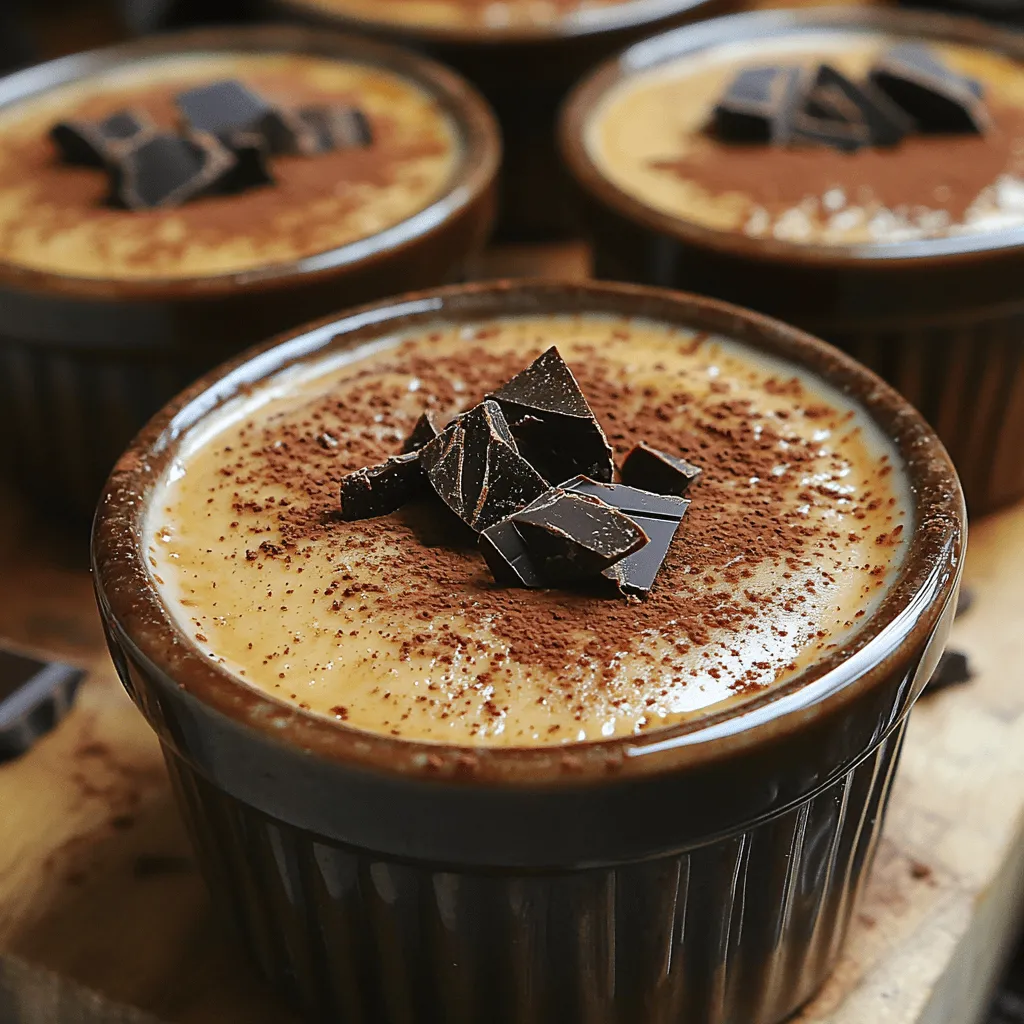Introduction
There’s a certain magic that comes with homemade recipes, often steeped in tradition and passed down through generations. They evoke a sense of warmth and nostalgia, transforming simple ingredients into comforting delights that bring people together. One such recipe that embodies this essence is the rich espresso custard pots. This indulgent dessert not only satisfies your sweet tooth but also serves as a delightful showcase for the bold flavor of espresso.
In today’s fast-paced world, where quick fixes often overshadow culinary artistry, taking the time to create something from scratch can be immensely rewarding. These custard pots, with their silky texture and deep coffee flavor, are perfect for home cooks and food enthusiasts alike. They offer a unique way to enjoy the rich taste of espresso, whether you’re entertaining guests or simply treating yourself after a long day.
Using fresh ingredients and traditional methods is crucial in crafting the perfect custard. The quality of your espresso, eggs, and cream will significantly impact the final product, elevating it from ordinary to extraordinary. This recipe embraces these principles, ensuring that each spoonful delivers a burst of flavor while also being a feast for the eyes.
Whether you’re a seasoned chef or a beginner in the kitchen, the rich espresso custard pots promise to be a rewarding culinary experience. Let’s delve into the key ingredients that make this recipe not only delicious but also a wholesome choice.
Understanding the Ingredients
Key Ingredients Overview
To create the perfect rich espresso custard pots, you’ll need a handful of essential ingredients:
1. Espresso: The star of the show, espresso provides a deep, robust flavor that forms the backbone of this dessert. Using freshly brewed espresso will enhance the richness of your custard.
2. Eggs: Eggs are crucial for thickening the custard and providing a creamy texture. They also add richness and help set the custard as it bakes.
3. Heavy Cream: For a luscious mouthfeel, heavy cream is the ideal choice. It adds richness and balances the boldness of the espresso.
4. Sugar: A touch of sugar is necessary to sweeten the custard, allowing the natural flavors of the espresso to shine without being overpowering.
5. Vanilla Extract: A hint of vanilla enhances the overall flavor profile, providing warmth and depth to the custard.
Importance of Quality Ingredients
Quality ingredients can make all the difference in your cooking and baking. For this recipe, using freshly ground espresso beans brewed into a shot of espresso instead of instant coffee will elevate the flavor. Similarly, opting for free-range or organic eggs ensures a richer taste and better texture. Heavy cream should also be of high quality, as it contributes to the custard’s luxurious consistency.
Not only do premium ingredients improve the taste, but they also enhance the nutritional profile of the dish. For instance, using organic eggs means you’re supporting sustainable farming practices while benefiting from eggs that are rich in nutrients.
Seasonal Considerations for Sourcing Ingredients
When preparing rich espresso custard pots, consider the seasonality of some ingredients. While eggs and sugar are available year-round, the freshness of your espresso can vary based on the beans you choose. Look for seasonal coffee blends to enjoy unique flavors throughout the year. Additionally, if you plan to serve these custard pots with garnishes like fresh berries or seasonal fruits, sourcing local produce will not only enhance the flavor but also support local farmers.
Alternative Ingredients for Dietary Preferences
This recipe can be easily adapted to accommodate various dietary needs. For those looking for a gluten-free option, rest assured that this custard is naturally gluten-free, as it contains no flour. If you’re interested in a vegan variation, consider using a plant-based milk like almond or coconut milk in place of heavy cream and a vegan egg substitute to mimic the custard’s texture. Additionally, using a high-quality vegan espresso will ensure that the flavor remains rich and satisfying.
Now that we’ve covered the essential ingredients and their significance, let’s move on to the step-by-step preparation of these delicious espresso custard pots.
Step-by-Step Preparation
Detailed Preparation Instructions
1. Gather Your Ingredients: Start by measuring out your ingredients. You will need 1 cup of freshly brewed espresso, 3 large eggs, 1 cup of heavy cream, 1/2 cup of granulated sugar, and 1 teaspoon of vanilla extract.
2. Prepare the Espresso: Brew your espresso using your preferred method, whether it’s a traditional espresso machine, stovetop moka pot, or Aeropress. Allow the espresso to cool slightly while you prepare the other ingredients.
3. Whisk the Eggs: In a medium mixing bowl, crack the eggs and whisk them until they are well combined. This step is crucial for ensuring a smooth custard without any egg clumps.
4. Combine Ingredients: In a saucepan over medium heat, combine the heavy cream, sugar, and vanilla extract. Stir gently until the sugar has dissolved and the cream is warmed through. Do not let the mixture boil, as this could curdle the eggs when combined.
5. Temper the Eggs: Slowly pour the warm cream mixture into the bowl with the whisked eggs, whisking continuously. This process, called tempering, helps prevent the eggs from cooking too quickly and becoming scrambled.
6. Add the Espresso: Once the egg mixture is smooth and combined, add the cooled espresso and whisk until fully incorporated.
Importance of Preparation
Preparation is key when making custards, as it ensures that all ingredients meld together seamlessly. The process of tempering the eggs is particularly important because it allows the custard to thicken gently without risking curdling. Take your time during this step for the best results.
Visual Cues and Descriptions
As you mix your ingredients, pay attention to the texture and color. The custard mixture should be velvety and should have a rich, dark brown hue from the espresso. This visual cue indicates that your mixture is ready for the next step.
Common Mistakes to Avoid
When preparing custards, there are a few common pitfalls to be aware of:
– Overheating the Cream: Always heat the cream gently to avoid curdling the eggs when combined.
– Not Tempering Properly: Failing to temper the eggs can result in a grainy custard. Make sure to whisk continuously while adding the warm cream mixture.
– Skipping the Strainer: After mixing, pour the custard through a fine mesh strainer into your serving pots to catch any bits of cooked egg for an ultra-smooth texture.
Now that your custard mixture is ready, let’s take a closer look at the cooking techniques involved in creating these delightful espresso custard pots.
Cooking Techniques
Explanation of Cooking Methods
The rich espresso custard pots are baked using the water bath method, also known as a bain-marie. This technique involves placing your custard-filled ramekins in a larger baking dish filled with hot water. This gentle cooking method ensures even heat distribution and prevents the custard from curdling.
Tips on Mastering These Techniques
To master the water bath method, follow these tips:
1. Choose the Right Ramekins: Make sure to use oven-safe ramekins that are deep enough to hold the custard mixture.
2. Prepare the Water Bath: Before pouring the custard into the ramekins, place them in a large baking dish. Carefully pour hot water into the dish until it reaches halfway up the sides of the ramekins. This will help maintain a consistent temperature during baking.
3. Monitor Baking Time: Custards can be tricky to bake, as overcooking can lead to a rubbery texture. Bake at a low temperature (around 325°F) and check for doneness by gently shaking the ramekins. The custard should be set around the edges but still have a slight jiggle in the center.
Importance of Timing and Temperature Control
Timing and temperature control are crucial for achieving the perfect custard consistency. Baking at a lower temperature allows for a gentle set, preventing the eggs from curdling. Keep a close eye on the custards during the last few minutes of baking to ensure they don’t overcook.
Variations in Cooking Methods
While the water bath is the traditional method for baking custards, you can also experiment with steaming them on the stovetop for a slightly different texture. This method involves placing the ramekins in a steamer basket over simmering water and covering them to cook gently. The result is a creamy custard that can be a delightful twist on the classic preparation.
With the custard mixture prepared and the cooking method understood, we can now look into the flavor profiles and enhancements that will elevate your rich espresso custard pots even further.

Suggestions for Complementary Spices and Herbs
When crafting your Rich Espresso Custard Pots, consider enhancing the flavor profile with complementary spices and herbs. A sprinkle of cinnamon can add warmth and depth, while a hint of nutmeg can introduce a subtle earthy aroma that pairs beautifully with espresso. Vanilla bean, although not a spice, can also elevate the custard’s sweetness and complexity—try infusing it into your cream mixture for an elevated flavor.
For those who appreciate a touch of adventure, consider adding a bit of cardamom. This fragrant spice complements coffee flavors exquisitely and can transform your custard into a unique dessert experience. If you enjoy a hint of bitterness, a dash of sea salt or even cayenne pepper can provide a surprising contrast that enhances the richness of the custard. Always remember to taste as you go, allowing you to adjust the spice levels to suit your personal preferences.
Adjusting Seasoning to Personal Taste
Adjusting the flavors in your espresso custard is a simple way to make the recipe your own. Start with the basic recipe and then gradually incorporate additional spices, tasting after each addition. If you prefer a sweeter custard, a splash of maple syrup or a few extra tablespoons of sugar can elevate the sweetness without overpowering the espresso flavor. Conversely, if you find the custard too sweet, a touch more espresso or a splash of brewed coffee can help balance the flavors.
Experimentation is key; don’t hesitate to swap out or reduce ingredients based on what you have on hand or what flavors resonate with you. Trust your palate, and let it guide you to the perfect custard.
Pairing Suggestions for Sides or Beverages
To create a well-rounded dessert experience, consider your beverage pairings. A rich custard like this pairs beautifully with a bold cup of coffee or a smooth espresso, enhancing the coffee notes in the dessert. Alternatively, a glass of dessert wine or a creamy liqueur, such as Baileys or Amaretto, can further complement the espresso and add an elegant touch to your serving.
For sides, think about light and fresh options that won’t overwhelm the custard. A simple fruit compote made from seasonal berries can add a refreshing contrast, while a dollop of whipped cream or a scoop of vanilla ice cream can introduce a creamy texture that balances the richness of the custard.
Serving Suggestions
When it comes to plating your Rich Espresso Custard Pots, presentation is key. Consider serving the custards in elegant glass ramekins or small jars to showcase the luscious layers. Top each pot with a light dusting of cocoa powder, a few coffee beans, or a delicate sprinkle of sea salt to add visual appeal and a hint of flavor contrast.
Ideal occasions for serving this dessert include family dinners, holiday gatherings, or intimate dinner parties. The custard’s sophisticated flavor and creamy texture make it a perfect finale to any meal, impressing your guests and leaving them satisfied.
For garnishes, consider adding a twist of citrus zest—like orange or lemon—to brighten the dish. Fresh mint leaves can also provide a pop of color and freshness, while chocolate shavings can add a decadent touch.
Culturally, custards have been enjoyed in various forms around the world, from French crème brûlée to Italian panna cotta. Serving this espresso version can evoke a sense of culinary tradition while allowing you to share a beloved dessert with your loved ones.
Nutritional Benefits
The main ingredients in your espresso custard deliver several nutritional benefits. Eggs, a key component, are an excellent source of protein and contain essential vitamins and minerals, including B vitamins and vitamin D. The dairy used in the custard is rich in calcium, contributing to bone health, while the espresso provides a natural source of antioxidants.
Incorporating this dessert into a balanced diet is achievable. Enjoy it in moderation as an occasional treat, allowing you to savor the rich flavors without compromising your health goals. The custard can be a delightful way to satisfy your sweet tooth while still being mindful of your overall dietary intake.
If you’re looking to adapt the recipe for various dietary lifestyles, consider using plant-based milk alternatives, such as almond or oat milk, for a dairy-free version. You can also experiment with egg substitutes like flaxseed meal or aquafaba, ensuring that everyone can enjoy this decadent dessert.
Storage and Reheating
To ensure your Rich Espresso Custard Pots stay fresh, proper storage is essential. After they have cooled to room temperature, cover each pot with plastic wrap or a lid and store them in the refrigerator. The custards can last for up to three days in the fridge, but for the best flavor and texture, it’s ideal to consume them within 48 hours.
When reheating, avoid the microwave, as it can cause the custard to curdle. Instead, place the pots in a preheated oven at a low temperature (around 300°F) for just a few minutes until warmed through. This gentle reheating method helps maintain the custard’s creamy texture.
If you find yourself with leftover custard, consider repurposing it into new meals. Use it as a filling for pastries or tarts, or fold it into pancakes for a delicious breakfast twist. The custard can also be drizzled over fresh fruit or used as a decadent layer in a trifle.
Conclusion
In summary, the Rich Espresso Custard Pots are a sophisticated dessert that not only satisfies your sweet cravings but also invites creativity in the kitchen. The combination of smooth custard and bold espresso creates an indulgent experience that is both comforting and elegant. With the option to adjust spices, experiment with pairings, and present the dish beautifully, this recipe can easily become a staple in your dessert repertoire.
Embrace the joy of cooking and sharing food with loved ones by making this delightful custard. Whether you choose to stick to the classic recipe or experiment with your own variations, the satisfaction of creating something delicious will always shine through. So gather your ingredients, invite friends or family over, and indulge in the rich flavors of your homemade espresso custard pots.

